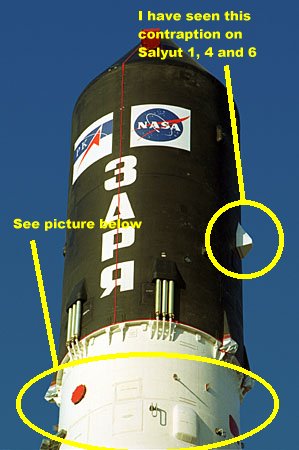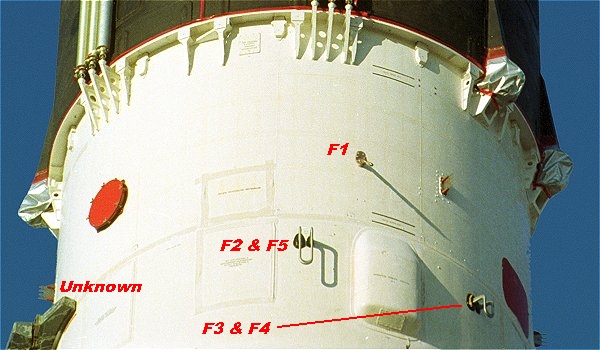RF systems on the Proton booster
Picture from NASA's PAO FTP
site
 The
table below is valid for the Proton-K/DM vehicle and is derived from the
Proton rocket handbook published on-line by ILS and from data published
by Keith Stein on the Hearsat-L listserver. I think all transmitters and
antennas for the first three are mounted in the third stage, where the
guidance avionics is located. The picture on the right shows the top of
the third stage of the proton that launched Zarya, the initial element
of the International Space Station
The
table below is valid for the Proton-K/DM vehicle and is derived from the
Proton rocket handbook published on-line by ILS and from data published
by Keith Stein on the Hearsat-L listserver. I think all transmitters and
antennas for the first three are mounted in the third stage, where the
guidance avionics is located. The picture on the right shows the top of
the third stage of the proton that launched Zarya, the initial element
of the International Space Station
| # |
Fx
(MHz) |
Bandwidth
(MHZ) |
Pwr
(dBW) |
Use |
| 1 |
192 |
0.256 |
20.8 |
TM stage 1 |
| 2 |
136.75 |
3.0 |
11.8 |
TM stage 1 |
| 3 |
240 |
0.256 |
20.8 |
TM stage 2 |
| 4 |
232 |
0.256 |
20.8 |
TM stage 3 |
| 5 |
132.4 |
3.0 |
11.8 |
TM stage 3 |
| 6 |
923 |
0.5 |
9.0 |
Block DM Tx |
| 7 |
769 |
0.5 |
- |
Block DM Rx |
| 8 |
2805 |
40 |
20 |
Block DM radar Tx |
-
This is an extremely strong
transmitter and the frequency is that used by Salyut 4, Soyuz 16, Soyuz
ASTP, Soyuz 22. Proton handbook gives modulation as "PM", but this is the
modulation also given for the radar transponder for Proton-M, so probably
PM stands for "pulse modulation" as well as "phase modulation". The bandwidth
is quite similar to that observed in VHF transmissions from Soviet/Russian
satellites using both PPM-AM
and PCM/FM.
-
Decimals given by Keith Stein.
The Proton manual says "137 MHz"
-
This frequency has also been
used by Yantar photo-reconnaissance satellites and the modulation in that
case was PCM/FM.
-
This frequency has also been
used by Zenit photo-reconnaissance satellites and the modulation in that
case was PPM-AM
(and later PCM/FM
when the frequency moved from 232.0 to 231.5 MHz).
-
Decimals given by Keith Stein.
The Proton manual says "132 MHz"
-
This is the typical downlink
frequency for the command-verification and telemetry link used by Energia
spacecraft and is probably more precisely 922.75 MHz.
-
This is the coherent uplink
coherent with downlink 6. The "turnaround ratio" is 126/105, so the exact
uplink corresponding to 922.75 MHz is 768.96
-
The frequency is an interpretation
of Keith Stein's number 2800-2810 MHz. The bandwidth is taken from the
figure for the "tracking" transmitter of Proton-M in the Proton manual.
A blow-up of the lower section
of the picture above shows four types of antennas clearly. I have made
educated guesses as to which antenna fits which frequency.The unknown antenna
looks like the 630-640 MHz antennas on Mir and Zarya itself. It could be
a feature specific for the launch of Zarya to transfer telemetry from Zarya
to the ground also during the launch phase.


 Back
to Space Radio Notes
Back
to Space Radio Notes
 The
table below is valid for the Proton-K/DM vehicle and is derived from the
Proton rocket handbook published on-line by ILS and from data published
by Keith Stein on the Hearsat-L listserver. I think all transmitters and
antennas for the first three are mounted in the third stage, where the
guidance avionics is located. The picture on the right shows the top of
the third stage of the proton that launched Zarya, the initial element
of the International Space Station
The
table below is valid for the Proton-K/DM vehicle and is derived from the
Proton rocket handbook published on-line by ILS and from data published
by Keith Stein on the Hearsat-L listserver. I think all transmitters and
antennas for the first three are mounted in the third stage, where the
guidance avionics is located. The picture on the right shows the top of
the third stage of the proton that launched Zarya, the initial element
of the International Space Station
